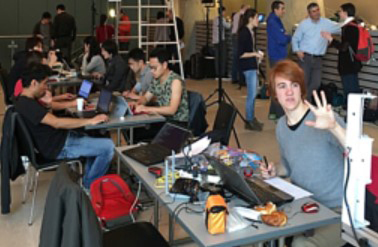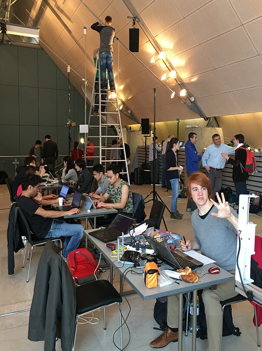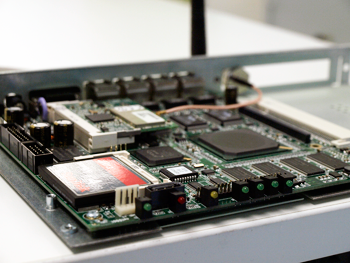IMDEA Networks

La tecnología de localización en interiores se simplifica
13 Junio 2016

La localización en interiores tiene potencial para transformar la forma de navegación en interiores del mismo modo en que el GPS ha transformado el modo de navegación en el exterior. En los últimos quince años, tanto las universidades como las empresas del sector han propuesto y han experimentado con diversas tecnologías de localización en interiores, siendo su principal reto el que las soluciones propuestas se evalúan bajo condiciones diferentes, lo cual dificulta establecer comparaciones en cuanto a su rendimiento.
La Microsoft Indoor Localization Competition [1] (Competición de localización en interiores de Microsoft) tiene como objetivo aunar en tiempo real, o casi en tiempo real, tecnologías de localización en interiores y comparar su rendimiento en el mismo espacio, resolviendo el problema de la ausencia de un entorno común equiparable. . La competición, ya en su tercera edición, tuvo lugar en Viena, Austria, los días 10 y 11 de abril de 2016. El entorno de evaluación era muy exigente, ocupaba dos pisos con metal, y el área total de la evaluación era de aproximadamente 500 m2.
Las presentaciones se clasificaron en dos categorías: localización 3D y localización 2D. A los equipos de la categoría de localización 3D se les pidió instalar un hardware adaptado y ofrecer localizaciones 3D durante la evaluación. A los de la categoría de localización 2D, en cambio, no se les solicitó un hardware adaptado (simplemente dispositivos genéricos (Off-The-Shelf)), y que comunicaran localizaciones 2D durante la evaluación. En la primera de las dos jornadas, los equipos dispusieron de siete horas para instalar y calibrar sus sistemas y, en la segunda, cada uno de los equipos ofreció las coordenadas de 15 puntos de ensayo con realidad del terreno. Al final, la métrica de la evaluación se basaba en el error medio de localización a lo largo de los 15 puntos de ensayo.
 |
 |
Un equipo de investigadores del Pervasive Wireless Systems Group, bajo la dirección del Dr. Domenico Giustiniano, del IMDEA Networks Institute [2], participó con su solución en la categoría 2D. Al concluir la competición, el equipo de investigadores de IMDEA Networks obtuvo un error medio de 3,17 metros, clasificándose en el quinto lugar de los diez equipos que llegaron a la final. (De los quince equipos inicialmente representados en la competición en la categoría 2D, únicamente diez consiguieron figurar en la clasificación definitiva).
La propuesta que presentaron los investigadores de IMDEA Networks en la Microsoft Indoor Localization Competition se ejecuta en hardware Wi-Fi básico, funciona mediante Puntos de Acceso Wi-Fi (APs) y mide el tiempo de retorno (ToF, Time-of-Flight) de tramas de datos estándar 802.11 hacia dispositivos móviles. La solución propuesta fue la única que no precisó software personalizado en el dispositivo móvil, ni tampoco inputs de sensores inerciales en el dispositivo móvil. Se necesitaría, simplemente, conectar el dispositivo móvil a los Puntos de Acceso Wi-Fi genéricos con un firmware personalizado que opera en el núcleo de la máquina de estado 802.11 MAC (control de acceso al medio) de un chip Wi-Fi de bajo coste (el coste del chip por unidad es de menos de tres dólares).
La solución de IMDEA Networks es la más sencilla de las que se pueden encontrar hoy para configurar de forma rápida un sistema de posicionamiento nuevo en entornos interiores mediante un hardware básico. Soluciona los siguientes tres problemas típicos que presentan otras tecnologías de localización en interiores: (i) una calibración manual in situ exhaustiva y costosa; (ii) tener que instalar una aplicación dedicada en dispositivos móviles, cuando esto no es necesario; y (iii) evita que se agote más rápidamente la batería del dispositivo móvil debido a los sensores inerciales y al uso del software.
La solución de IMDEA Networks estima la posición de los dispositivos compatibles con el estándar 802.11 como son los teléfonos inteligentes, con una distancia desde cada uno de los puntos de acceso AP a los objetivos móviles estimada con mediciones del rango del tiempo de retorno (ToF) y basada en un algoritmo de formación de entorno adaptable. En la tercera de las siguientes referencias [3] que figura a continuación se amplían datos.
Recursos:
[1] http://research.microsoft.com/en-us/events/msindoorloccompetition2016/default.aspx
[2] http://persys.networks.imdea.org/team
[3] A. Marcaletti, M. Rea, D. Giustiniano, V. Lenders, and A. Fakhreddine, “Filtering noisy 802.11 time-of-flight ranging measurements,” in CoNEXT ’14. ACM, 2014, pp. 13–20.


Comentarios recientes